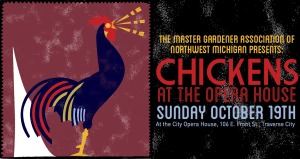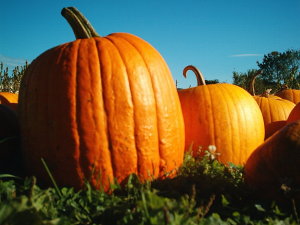Contents (click a title or scroll)
Why Chickens in the Garden?
Food of the Month: Pumpkin

Why Chickens in the Garden?
Michele Worden
There has been a recent explosion of urban and suburban folks keeping chickens in their back yards. There are even schools that keep chickens in their school yard. Why has keeping chickens become so popular and moved off of the farm? Do chickens provide a benefit to home gardeners beyond eggs? To schools? And can anybody have chickens?
On Sunday October 19th, the Master Gardener Association of Northwest Michigan held an event called “Chickens at the Opera House” to answer these and other questions. The featured speaker, Jessi Bloom, is the author of a new book titled “Free-Range Chicken Gardens” published by Timber Press. Her talk was entitled “What the Cluck?!” and talked about integrating chickens into your garden.
Chickens provide many benefits in a home garden. They provide IPM – integrated pest management – by eating bugs and weeds. Their waste is a powerful fertilizer; and chicken scratching can loosen and improve the soil. Chickens even keep the grass mowed and thus saves labor for the home gardener. The eggs (and meat) they produce are very nutritious – perhaps more so than eggs and meat from factory farms, and, as an added bonus, you know where your food came from.
But why chickens in school yards? Two area schools that keep chickens, The Children’s House and The Greenspire School, keep chickens next to their school gardens. Both schools are based upon the Montessori pedagogy. In Montessori, students keep animals as an aid to learning about animals (a living laboratory), and rotating chore assignments to care for animals (and the school garden) helps develop responsibility and character. In 2012, students at The Greenspire School hosted Poultry Palooza, a program of MSUE and 4H, and incorporated learning about chickens into their project-based learning curriculum. Sarah Payette of The Greenspire School says “there are so many cross-curricular connections that can be made by the students in raising chickens, from the life cycle of a chicken in science, to making deviled eggs in our cooking curriculum.” (The Greenspire chickens are named Olaf (little black one), Boo, Nugget, Henny, Buddah and Splash, and they are Black Copper and Blue Copper Marans. You can visit them on the Commons, in the school courtyard.) The Greenspire students also spent the latter part of the 2013-14 school year learning about permaculture and designing permaculture projects for their school landscape.
Apparently the secret to incorporating chickens is creating a habitat for chickens and gardening using the design philosophy of permaculture. Jessi Bloom is a an award-winning landscape designer, a certified professional horticulturalist and certified arborist, as well as a long-time chicken owner with a free-ranging flock in her home garden. It is interesting that she practices permaculture design, which is a design philosophy that guides the creation of garden habitats as ecological systems, and emphasizes sustainability and (plant) self-sufficiency. (On a side note – I have heard proponents of permaculture talk about it as an alternative to horticulture, which made no sense to me as a Master Gardener. Jessi’s approach of applying horticulture principles in a permaculture framework made more sense to me and I embrace her ideas.) Since The Greenspire School has a core mission of teaching about environmental studies and sustainability, permaculture and chickens fit perfectly into their school environment and educational goals. (Greenspire also raises rabbits now, Mr. Thumper and Pumpernickel, with their chickens – there is apparently a symbiotic relationship between them too. And the resulting compost is wonderful stuff.)
Jessi did an informal survey of the audience and almost all of the 70-80 people in attendance were raising chickens. Many raised their hands and said they had issues of dead earth where chickens had been housed. Jessi talked about understanding the capacity of your space for chickens (prevent over-crowding) to determine how many your garden can support sustainably and also moving the area that the chickens are actively working to prevent “overgrazing”. Allowing chickens “free range” is a more sustainable option that confining chickens to a small, stationary, space. But who or where can you have chickens? That seems to vary all over the map. In the city of Traverse City there is a local ordinance that allows chicken coops in the city limits, but not roosters, who are perceived to be a nuisance. On Old Mission Peninsula, people with a Traverse City mailing address, but not in the city proper, are still not allowed to have chickens, even though the peninsula is more rural in character than downtown Traverse City. The lesson here? Check with your local township office to see what chicken ordinances exist in your area. Also, keep on good terms with your neighbors (perhaps free eggs?) so that existing anti-chicken ordinances will not be enforced should you choose to become part of the forefront of this growing movement!

photo via wikiemedia commons
Food of the Month: Pumpkin
Michele Worden
Latin Name: genus Cucurbita
Family: family Cucurbitaceae (gourd family along with winter squash like Acorn or butternut)
Description: Pumpkin is a fruit of one of the species Cucurbita pepo, Cucurbita mixta, Cucurbita maxima, and Cucurbita moschata, and is believe to be native to North America. They grow on a vine and can have an orange, yellow, white or green-blue shell, creased from the stem to the bottom, containing the seeds and pulp. They ripen in fall and are cultivated for agricultural (animal feed), ornamental and culinary uses.
Origin: Now found all over the world but believed to originate in North America.
Cultivation (how and where): Pumpkin is a warm season crop that needs a 70 F soil to germinate and grow. It also needs a very moisture retentive soil. Pumpkins are monoecious – they have both a male and female flower can be pollinated by the native squash bee Peponapis pruinosa, European honeybees or hand pollination to produce fruit.
Fun Fact: All giant pumpkins are Curcubita Maxima cultivars and are called ‘Atlantic Giants’. Every year giant pumpkin growers compete in contests to see who can grow the largest pumpkin. The current world record holder is Chris Stevens’s 1,810-pound Atlantic Giant pumpkin, which in October 2010. Another fun fact is that 95% of all pie pumpkin are grown in Illinois and processed in Morton, Illinois by Nestle.
Nutrition: For the flesh, the main nutrients are lutein and both alpha and beta carotene, the latter of which generates vitamin A in the body. Seeds, or Pepitos, are good sources of protein, as well as iron, zinc, manganese, magnesium, phosphorus, copper, and potassium.
Culinary Uses: Most parts of the pumpkin are edible, including the fleshy shell, the seeds, oil from the seeds, the leaves, and even the flowers. Parts of the pumpkin are eaten all over the world.
Flesh: Ripe pumpkin can be boiled, baked, steamed, or roasted. In North America we eat it mashed in soups and purees and pies. Pumpkins that are still small and green may be eaten in the same way as squash or zucchini. In the Middle East, pumpkin is used for sweet dishes like halawa yaqtin. In South Asian countries such as India, pumpkin is cooked with butter, sugar, and spices in a dish called kadu ka halwa. In Japan, small pumpkins are served in tempura. In Myanmar, pumpkins are used in both cooking and desserts (candied). In Thailand, small pumpkins are steamed with custard inside and served as a dessert. In Italy, it can be used with cheeses as a savory stuffing for ravioli.
Leaves: In China and Kenya the leaves are used as a vegetable and in soups.
Seeds: In Mexico and the U.S., the seeds are often roasted and eaten as a snack. The seeds are a popular sunflower seed substitute. Also, pumpkin can be used to flavor both alcoholic and nonalcoholic beverages. Pumpkin seed oil is a delicacy in Austria and Eastern Europe used in salad oil in desserts. It has a nutty flavor.
Flowers: In the southwestern United States and Mexico, pumpkin and squash flowers are a popular and widely available food item. They may be used to garnish dishes, and they may be dredged in a batter then fried in oil.
Medicinal Uses: The medicinal properties of pumpkin include anti-diabetic, antioxidant, anti-carcinogenic, and anti- inflammatory. Pumpkin seed oil contains essential fatty acids that help maintain healthy blood vessels, nerves and tissues and is used to treat irritable bowel syndrome. Seeds and oil have been a folkloric remedy for prostrate issues in men. Pepitas contain high levels of L-tryptophan that are believed to help with anxiety and depression.
Variety grown or eaten as school: In 2010 we grew a french heirloom called ‘Rouge d’Vif Etampe’ otherwise known as Cinderella Pumpkins. This year we grew New England Pie Pumpkins.
Literature: Pumpkins feature prominently in many stories such as the ‘Legend of Sleepy Hollow’, ‘Cinderella’, and Harry Potter series (pumpkin juice) and many more.
Cultural: Across the US in the fall there are Pumpkin Festivals, giant pumpkin weighing contests, pumpkin chunking events (where pumpkins are thrown using a catapult). Pumpkins are carved as jack o’ lanterns for Halloween. Pumpkin pie is a featured food at Thanksgiving and Christmas feast.
